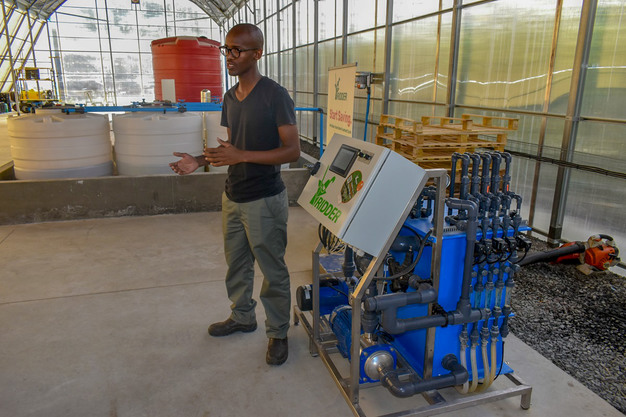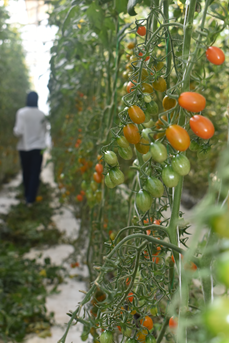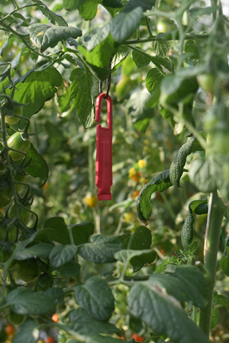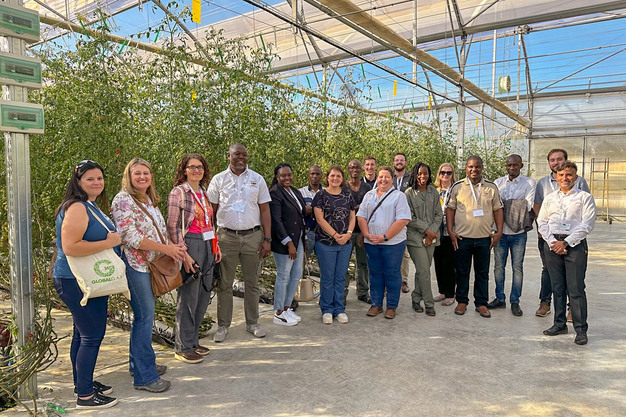Halfway through the second tomato cropping season of the University of Stellenbosch's Horti Demo Centre greenhouse, but what its director Dr Estelle Kempen likes most, is not inside but outside: "In my opinion, the rainwater collection tanks are the best feature of the greenhouse. There are not nearly enough South African greenhouses with rainwater tanks, but I think it should be mandatory to collect rainwater when you put up a greenhouse."
Right: rainwater tanks and water recycling should be a sine qua non at South Africa greenhouses
Each of the two tanks has a capacity of 250m3; they could have installed two more since by July last year, both were already full. "We couldn't have done this without the rainwater tanks," she says. "Because we start with rainwater, the quality of our nutrient solution is quite good. We don't get to a point where we need to flush out salts."
Recycling used water
The second way in which the greenhouse saves water is through directing excess and nutrient-rich water back for recycling (instead of letting it loose into the environment) which few South African greenhouses do. "We prefer using 70% rainwater and 30% recycled water, and in the process we save a lot on fertilizer as well," says Adaduma Msana, who has been involved with the project since the start.
Recycled water is led through two separate filters to a tank where ultraviolet light disinfects it; if it is not on standard, it is automatically led back to repeat the process. Irrigation is linked to light intensity or radiation (measured in Joules), thus to photosynthesis and water requirements. The system automatically adjusts to changes in temperature and solar radiation and applies water in 300 second pulses.

Adaduma Msana, principal technical assistant at the Horti Demo Centre.
Impact of outside atmosphere
Structural damage from recent gale force winds could have been much worse if it weren't for the quick reaction time of the automated vents, Msana notes.
Their Ridder control system picked up the risk and when winds reached 5m per second, the vents started closing and were fully shut by the time the full force of the gale swept over. "The structure is very sensitive to high wind speeds," he says. On the day of the visit by attendees to the GLOBALG.A.P. South Africa tour, the temperature was 25.3°C outside and 26.9°C inside. Both the leeward and the windward vents were 100% open; the windward vents opened slightly less. In the absence of a discernible direction, both act as leeward vents.
On the day of the visit by attendees to the GLOBALG.A.P. South Africa tour, the temperature was 25.3°C outside and 26.9°C inside. Both the leeward and the windward vents were 100% open; the windward vents opened slightly less. In the absence of a discernible direction, both act as leeward vents.
"We keep the temperature inside the greenhouse at lower than 30°C and just above 20°C. When temperatures increase, the vents automatically open," Msana explains.
A screen below the roof shuts when temperatures go below 15°C to trap warmth inside. He remarks that the screen is very effective at diffusing light within the greenhouse. When humidity approaches 60%, fog misters switch on to keep at around that level, but when it reaches 85% the fan kicks in and vents are opened slightly for dehumidification.
Heaters were not installed due to doubts about its return on investment given the relative mildness of Cape winters. "After two seasons it would have been beneficial to have a heating system, not necessarily for heat but for evaporation," Dr Kempen observes. "As soon as winter sets in, and it starts raining, especially like it did last year, your humidity builds up, and fungal diseases take over."
Living with insects: one of the big lessons "As you stand here, you can see the whitefly flying around which would give most farmers the heebie-jeebies, but there's an economic threshold: you don't have to get out the big guns until it's really needed," she remarks. "In our greenhouse there is Tuta, there is whitefly, we had some red spider mite. When you do integrated pest management, you're never going to have a zero number of insects. South African farmers are not used to farming like that, and I had to learn this as well. It's one of the big lessons we've had to learn."
"As you stand here, you can see the whitefly flying around which would give most farmers the heebie-jeebies, but there's an economic threshold: you don't have to get out the big guns until it's really needed," she remarks. "In our greenhouse there is Tuta, there is whitefly, we had some red spider mite. When you do integrated pest management, you're never going to have a zero number of insects. South African farmers are not used to farming like that, and I had to learn this as well. It's one of the big lessons we've had to learn."
Right: pheromone to disrupt Tuta absoluta reproduction.
Kholosa Nakani, heading up operational management and marketing, says that weekly scouting with a magnifying glass is facilitated by the Koppert app advising on the steps to be taken, depending on the population levels. Besides whitefly and thrips, the bane in the life of tomato growers Tuta absoluta are present in the greenhouse, but numbers are limited through mating disruption.
"We try to be biological in the greenhouse, unless the infestation is beyond our control," Nakani says, and Dr Kempen adds that in such an intensive system with people working four or five days a week, chemicals can't be freely used.
Extended propagation to stretch the season
The Rijk Zwaan varieties in the greenhouse were bred for their taste. "To give them an extra boost, we start with grafting. It's something the Dutch taught us: seedlings are grown on in cubes in a different greenhouse, while the current crop is still growing. When the plants in the cube are about 30cm high, they are brought here and plugged into the slab of buffered coconut peat."
The tomatoes are packed into retail programmes, but the main purpose of the Horti Demo Centre is teaching. "For our undergraduate students this is part of their curriculum with a compulsory number of hours worked in the greenhouse. With the expertise of our partners, we also offer short courses which are accredited by the university for farmers and anyone in the industry."
The Horti Demo Centre has been a collaboration between the University of Stellenbosch, the Netherlands Enterprise Agency (Rijksdienst voor Ondernemend Nederland, RVO) and a consortium of Dutch greenhouse technology providers.

GLOBALG.A.P. tour attendees at the Horti Demo Centre (photo: Christi Venter)
For more information:
Dr Estelle Kempen
Horti Demo Centre
Email: [email protected]
https://hortidemocentre.co.za/
